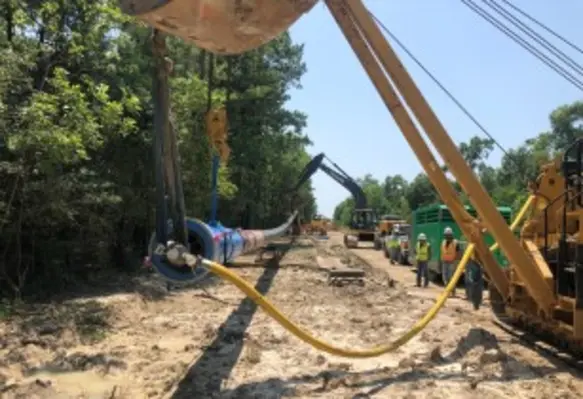A pipe rammer can create the least amount of surface disruption possible, especially when something goes wrong at the jobsite and rapid action is needed
Jake Gautreaux, founder and co-owner of Directional Service South, explained. “For this project, we were tasked with installing several miles of 500 mm steel gas transmission main with installation lengths ranging from 150 to 920 m and ScarGuard-coated pipe welds. The whole project covered 30 HDD crossings. After one particular 360 m long installation, crews noticed an issue with some damage to the pipe. It was going to need to be replaced.”
According to pipe ramming specialist Rick Melvin from TT Technologies, pipe extraction is an evolution of existing ramming techniques developed over time. “The extraction process is really an extension of several HDD Assist methods we developed over the years using the pneumatic pipe rammer”, he says. “The things we’ve learned from salvaging stuck bores and retrieving drill stems with the help of pipe rammers have enabled full scale pipe extraction to become a reality.”
Pipe extraction: it’s about the right balance of force
Pipe extraction has been part of this process. “Contractors have been using pipe rammers on HDD projects to help install pipe under challenging areas like waterways for a long time,” Melvin explained. “Through the pullback assist methods, percussive force from a pipe rammer on the back end of a pipe string can help prevent hydro lock and ensure a smooth installation. Now, when things don’t go as planned, a drill stem breaks or a segment of pipe needs to be removed, we can do those things as well, again using the percussive power of the pipe rammer to help remove or salvage those products from the ground.”
The rammer’s percussive force gets the pipe moving
Back to Houston: Regarding the area in question, the whole installation turned out trickier than expected. “We installed the crossing without trouble but couldn’t tie it in right away,” noted Gautreaux. “We had to spin around and install the next crossing, drilling the other way. So, we were basically sitting on top of the one we just put in. Only after we had installed that next pipe section, we were able to access that first pipe.” That’s when they noticed the damage: A large scratch ran across the whole visible pipe length and breached the coating. “A quick decision regarding the future of that section had to be taken.”
When the extraction works began, the pipe had already been in the ground for two months. “The wrapping on the welds is abrasive and creates friction, which made pulling the pipe out extremely difficult,” said Gautreaux. Initial attempts to use static pull force to remove the pipe failed. “In addition, we wanted to pull in the 360 m replacement section of pipe at the same time. That’s when we brought in the GRUNDORAM Taurus rammer to complete the extraction configuration.”
After 10 minutes of ramming and pulling, the pipe finally started moving. Overall, it took two 12 hour days to remove the pipe and pull in the replacement simultaneously. The crews were able to extract the 360 m pipe in two 180 m sections. “The hammer worked great in breaking the line free allowing equipment to continue movement,” said Gautreaux. “That’s the reason why we bought the hammer, to have it in our fleet and on the jobsite. Time is of the essence when problems arise.”









